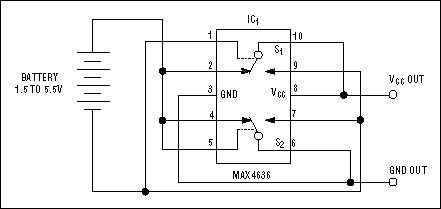
The ESD-protection diodes in IC1 guarantee startup and act as a full-wave rectifier. MOSFETs internal to the analog switch turn on when the battery voltage exceeds 1V. Their less-than-20-nsec turn-on time enables the circuit to maintain normal operation by quickly swapping the leads of a reversed-polarity battery connection. The circuit resistance depends on the battery voltage. When the circuit operates from four NiCd, NiMH, or alkaline cells, the resistance in each leg of the rectifier is 2.5Ω (5Ω total). Operation with a two-cell battery (2.4V to 3V) yields a total resistance of 10Ω. IC1 is rated for operation to 5.5V with 30-mA continuous current, making the circuit useful for cordless phones, portable audio equipment, hand-held electronics, and other light- to medium-current applications. IC1's miniature 10-pin µMAX package takes less space than four through-hole signal diodes and is almost as small as two SOT-23 dual signal diodes.

Figure 1. This circuit senses battery polarity and then quickly connects the load or swaps the battery leads.
A similar version of this article appeared in the December 21, 2000 issue of EDN.
欢迎分享,转载请注明来源:内存溢出

 微信扫一扫
微信扫一扫
 支付宝扫一扫
支付宝扫一扫
评论列表(0条)